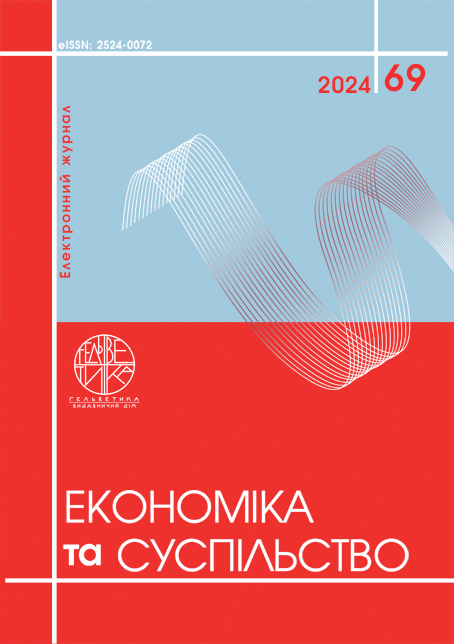ADAPTATION OF THE PCDL MODEL FOR UNIVERSITY BRAND MANAGEMENT IN THE DIGITAL ENVIRONMENT
Abstract
The study examines the adaptation of the PCDL model, developed by the author based on Ghodeswar’s model [6], to address the challenges and leverage the opportunities of digital transformation in university brand management. The focus is placed on four key components of brand management: brand positioning, communication, brand value realization, and brand value utilization. The relevance of this study arises from the increasing digitalization of higher education, where traditional brand management strategies are insufficient to meet the expectations of digitally oriented stakeholders and the demands of global competitiveness. The research employs a mixed-method approach, combining an in-depth analysis of contemporary literature, theoretical models, and practical examples of digital brand management strategies used by leading universities worldwide. Special attention is given to the integration of modern technologies, such as big data analytics, artificial intelligence, and blockchain, into the adapted PCDL model. These technologies enhance transparency, stakeholder trust, and personalized communication, enabling effective operation in the stochastic digital environment. The study's findings present a set of innovative metrics for evaluating the effectiveness of digital brand management strategies within each component of the PCDL model. The results provide universities with practical tools to strengthen competitive positions, build stakeholder trust, and effectively respond to the challenges of a dynamic digital landscape. Additionally, the proposed model emphasizes the importance of emotional engagement and interactive communication as key elements of modern university branding. The originality of the study lies in synthesizing traditional brand management theories with modern digital tools, resulting in a scalable model adapted to various educational contexts. Practical applications include strategies for enhancing university reputations, attracting international students, and ensuring financial stability through innovative brand management approaches. The adapted PCDL model offers a robust theoretical foundation and practical recommendations for universities striving to achieve strategic alignment within the global digital ecosystem.
References
Melewar, T. C., & Akel, S. (2006). The Role of Corporate Identity in the Higher Education Sector: A Case Study. Corporate Communications: An International Journal, 10(1), 41-57. https://doi.org/10.1108/13563280510578196
Hemsley-Brown, J., & Oplatka, I. (2006). Universities in a Competitive Global Marketplace: A Systematic Review of the Literature on Higher Education Marketing. International Journal of Public Sector Management, 19(4), 316–338. https://doi.org/10.1108/09513550610669176
Pinar, M., Girard, T., & Basfirinci, C. (2020). Examining the relationship between brand equity dimensions and university brand equity: an empirical study in Turkey. International Journal of Educational Management, 34(7):1119-1141. DOI:10.1108/IJEM-08-2019-0313
Castro-Gómez, J., Sánchez-Torres, J. A., & Ortíz-Rendón, P. A. (2024). Influence of sustainability in the positioning of the university brand: Study in universities in Medellín-Colombia. Heliyon, 10(9):1-20. DOI:10.1016/j.heliyon.2024.e30569
Aaker, D. A. (1991). Managing Brand Equity: Capitalizing on the Value of a Brand Name. Free Press. DOI:10.1016/0148-2963(94)90009-4
Ghodeswar, B. (2008). Building brand identity in competitive markets: A conceptual model. Journal of Product & Brand Management, 17(1), 4-12. doi: 10.1108/10610420810856468
Kaplan, A. M., & Haenlein, M. (2010). Users of the world, unite! The challenges and opportunities of social media. Business Horizons, 53(1), 59-68.
http://dx.doi.org/10.1016/j.bushor.2009.09.003
Hudson, S., Roth, M. S., Madden, T. J., & Hudson, R. (2015). The effects of social media on emotions, brand relationship quality, and word of mouth: An empirical study of music festival attendees. Tourism Management, 47, 68-76. https://doi.org/10.1016/j.tourman.2014.09.001
Chen, H., Chiang, R. H. L., & Storey, V. C. (2012). Business Intelligence and Analytics: From Big Data to Big Impact. MIS Quarterly, 36(4), 1165-1188.
Hootsuite: Social Media Marketing and Management Tool (2023): https://www.hootsuite.com/
Melewar, T. C., & Akel, S. (2006). The Role of Corporate Identity in the Higher Education Sector: A Case Study. Corporate Communications: An International Journal, 10(1), 41-57. https://doi.org/10.1108/13563280510578196
Hemsley-Brown, J., & Oplatka, I. (2006). Universities in a Competitive Global Marketplace: A Systematic Review of the Literature on Higher Education Marketing. International Journal of Public Sector Management, 19(4), 316–338. https://doi.org/10.1108/09513550610669176
Pinar, M., Girard, T., & Basfirinci, C. (2020). Examining the relationship between brand equity dimensions and university brand equity: an empirical study in Turkey. International Journal of Educational Management, 34(7):1119-1141. DOI:10.1108/IJEM-08-2019-0313
Castro-Gómez, J., Sánchez-Torres, J. A., & Ortíz-Rendón, P. A. (2024). Influence of sustainability in the positioning of the university brand: Study in universities in Medellín-Colombia. Heliyon, 10(9):1-20. DOI:10.1016/j.heliyon.2024.e30569
Aaker, D. A. (1991). Managing Brand Equity: Capitalizing on the Value of a Brand Name. Free Press. DOI:10.1016/0148-2963(94)90009-4
Ghodeswar, B. (2008). Building brand identity in competitive markets: A conceptual model. Journal of Product & Brand Management, 17(1), 4-12. doi: 10.1108/10610420810856468
Kaplan, A. M., & Haenlein, M. (2010). Users of the world, unite! The challenges and opportunities of social media. Business Horizons, 53(1), 59-68. http://dx.doi.org/10.1016/j.bushor.2009.09.003
Hudson, S., Roth, M. S., Madden, T. J., & Hudson, R. (2015). The effects of social media on emotions, brand relationship quality, and word of mouth: An empirical study of music festival attendees. Tourism Management, 47, 68-76. https://doi.org/10.1016/j.tourman.2014.09.001
Chen, H., Chiang, R. H. L., & Storey, V. C. (2012). Business Intelligence and Analytics: From Big Data to Big Impact. MIS Quarterly, 36(4), 1165-1188.
Hootsuite: Social Media Marketing and Management Tool (2023): https://www.hootsuite.com/

This work is licensed under a Creative Commons Attribution 4.0 International License.


